Related Research Articles
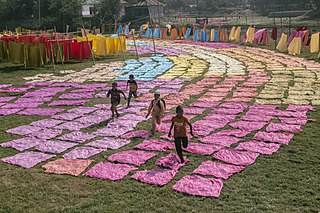
A dye is a colored substance that chemically bonds to the substrate to which it is being applied. This distinguishes dyes from pigments which do not chemically bind to the material they color. Dye is generally applied in an aqueous solution and may require a mordant to improve the fastness of the dye on the fiber.

Textile is an umbrella term that includes various fiber-based materials, including fibers, yarns, filaments, threads, different fabric types, etc. At first, the word "textiles" only referred to woven fabrics. However, weaving is not the only manufacturing method, and many other methods were later developed to form textile structures based on their intended use. Knitting and non-woven are other popular types of fabric manufacturing. In the contemporary world, textiles satisfy the material needs for versatile applications, from simple daily clothing to bulletproof jackets, spacesuits, and doctor's gowns.

Tie-dye is a term used to describe a number of resist dyeing techniques and the resulting dyed products of these processes. The process of tie-dye typically consists of folding, twisting, pleating, or crumpling fabric or a garment, before binding with string or rubber bands, followed by the application of dye or dyes. The manipulations of the fabric before the application of dye are called resists, as they partially or completely prevent ('resist') the applied dye from coloring the fabric. More sophisticated tie-dye may involve additional steps, including an initial application of dye before the resist, multiple sequential dyeing and resist steps, and the use of other types of resists and discharge.
Sulfur dyes are the most commonly used dyes manufactured for cotton in terms of volume. They are inexpensive, generally have good wash-fastness, and are easy to apply. Sulfur dyes are predominantly black, brown, and dark blue. Red sulfur dyes are unknown, although a pink or lighter scarlet color is available.

Dyeing is the application of dyes or pigments on textile materials such as fibers, yarns, and fabrics with the goal of achieving color with desired color fastness. Dyeing is normally done in a special solution containing dyes and particular chemical material. Dye molecules are fixed to the fiber by absorption, diffusion, or bonding with temperature and time being key controlling factors. The bond between the dye molecule and fiber may be strong or weak, depending on the dye used. Dyeing and printing are different applications; in printing, color is applied to a localized area with desired patterns. In dyeing, it is applied to the entire textile.

Textile manufacturing is a major industry. It is largely based on the conversion of fibre into yarn, then yarn into fabric. These are then dyed or printed, fabricated into cloth which is then converted into useful goods such as clothing, household items, upholstery and various industrial products.

Textile printing is the process of applying color to fabric in definite patterns or designs. In properly printed fabrics the colour is bonded with the fibre, so as to resist washing and friction. Textile printing is related to dyeing but in dyeing properly the whole fabric is uniformly covered with one colour, whereas in printing one or more colours are applied to it in certain parts only, and in sharply defined patterns.
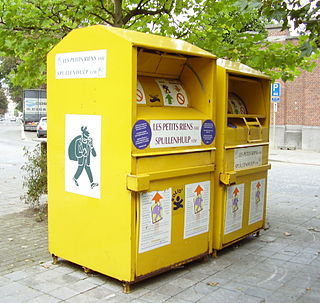
Textile recycling is the process of recovering fiber, yarn, or fabric and reprocessing the material into new, useful products. Textile waste is split into pre-consumer and post-consumer waste and is sorted into five different categories derived from a pyramid model. Textiles can be either reused or mechanically/chemically recycled.
Digital textile printing is described as any ink jet based method of printing colorants onto fabric. Most notably, digital textile printing is referred to when identifying either printing smaller designs onto garments and printing larger designs onto large format rolls of textile. The latter is a growing trend in visual communication, where advertisement and corporate branding is printed onto polyester media. Examples are: flags, banners, signs, retail graphics.

Natural dyes are dyes or colorants derived from plants, invertebrates, or minerals. The majority of natural dyes are vegetable dyes from plant sources—roots, berries, bark, leaves, and wood—and other biological sources such as fungi.

Dyeing is the craft of imparting colors to textiles in loose fiber, yarn, cloth or garment form by treatment with a dye. Archaeologists have found evidence of textile dyeing with natural dyes dating back to the Neolithic period. In China, dyeing with plants, barks and insects has been traced back more than 5,000 years. Natural insect dyes such as Tyrian purple and kermes and plant-based dyes such as woad, indigo and madder were important elements of the economies of Asia and Europe until the discovery of man-made synthetic dyes in the mid-19th century. Synthetic dyes quickly superseded natural dyes for the large-scale commercial textile production enabled by the industrial revolution, but natural dyes remained in use by traditional cultures around the world.
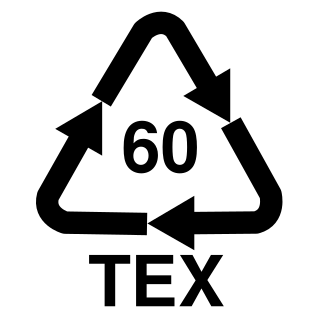
Cotton recycling is the process of converting cotton fabric into fibers that can be reused into other textile products.
Wet Processing Engineering is one of the major streams in Textile Engineering or Textile manufacturing which refers to the engineering of textile chemical processes and associated applied science. The other three streams in textile engineering are yarn engineering, fabric engineering, and apparel engineering. The processes of this stream are involved or carried out in an aqueous stage. Hence, it is called a wet process which usually covers pre-treatment, dyeing, printing, and finishing.
Green textiles are fabrics or fibres produced to replace environmentally harmful textiles and minimise the ecological impact. Green textiles are part of the sustainable fashion and eco-friendly trends, providing alternatives to the otherwise pollution-heavy products of conventional textile industry, which is deemed the most ecologically damaging industry.
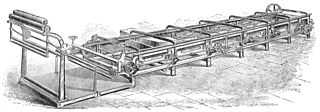
A stenter is a machine used in textile finishing. It serves multiple purposes, including heat setting, drying, and applying various chemical treatments. This may be achieved through the use of certain attachments such as padding or coating.
Batch dyeing is a method of dyeing a textile material. The method involves the gradual transfer of dye from a dye bath to the textile material in the same piece of equipment. The various methods of batch dyeing result from the type of machine used in the dyeing process. Common machinery used in the batch dyeing process include the jigger dyeing machine, winch dyeing machine, jet dyeing machine and beam dyeing machine.
Cationization of cotton is an electro kinetic phenomena for surface charge of cotton. The cotton surface is charged with positive ions. Cationization alters the characterization of the surface of the cotton which allows salt free dyeing and improves the dye ability of cotton. The process involves the chemical reaction of cationic reactive agents with cellulose.

Scouring is a preparatory treatment of certain textile materials. Scouring removes soluble and insoluble impurities found in textiles as natural, added and adventitious impurities, for example, oils, waxes, fats, vegetable matter, as well as dirt. Removing these contaminants through scouring prepares the textiles for subsequent processes such as bleaching and dyeing. Though a general term, "scouring" is most often used for wool. In cotton, it is synonymously called "boiling out," and in silk, and "boiling off."
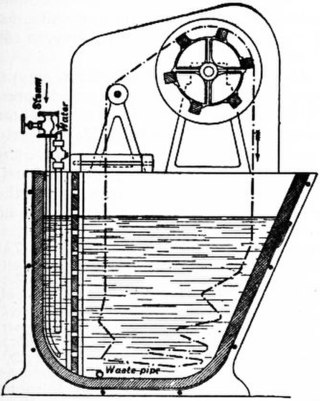
A Winch machine or winch dyeing machine is a type of dyeing machine suitable for piece dyeing. A winch is a simple machine. It is equipped with a winch to guide the fabric from the vat. It has a straight front and a curved back. Long lengths are pulled over the winch and sewn together to form an endless rope. The winch dyeing machine allows fabric ropes pulled from the front and dropping back into the dye liquor. The winch or beck dyeing machine is one of the oldest forms.
In textile processing, stripping is a color removal technique employed to partially or eliminate color from dyed textile materials. Textile dyeing industries often face challenges like uneven or flawed dyeing and the appearance of color patches on the fabric's surface during the dyeing process and subsequent textile material processing stages. Stripping is one of the reprocessing methods used to correct undesirable colors and flaws in dyed materials. The efficacy of this process relies on factors such as the dye type, fiber material, and the stripping agents utilized. Additionally, the procedure is recognized by alternative terms, namely back stripping or destructive stripping.
References
- 1 2 3 Khatri, Zeeshan; Memon, Muhammad Hanif; Khatri, Awais; Tanwari, Anwaruddin (2011-11-01). "Cold Pad-Batch dyeing method for cotton fabric dyeing with reactive dyes using ultrasonic energy". Ultrasonics Sonochemistry. 18 (6): 1301–1307. doi:10.1016/j.ultsonch.2011.04.001. ISSN 1350-4177. PMID 21550289.
- 1 2 3 4 Blackburn, Richard (2015-08-28). Sustainable Apparel: Production, Processing and Recycling. Woodhead Publishing. p. 147. ISBN 978-1-78242-357-7.
- 1 2 Khatri, Awais; Peerzada, Mazhar Hussain; Mohsin, Muhammad; White, Max (2015-01-15). "A review on developments in dyeing cotton fabrics with reactive dyes for reducing effluent pollution". Journal of Cleaner Production. 87: 50–57. doi:10.1016/j.jclepro.2014.09.017. ISSN 0959-6526.
- 1 2 3 Gordon, S.; Hsieh, Y. L. (2006-12-22). Cotton: Science and Technology. Woodhead Publishing. p. 367. ISBN 978-1-84569-248-3.
- ↑ "dye - Synthetic dyes | Britannica". www.britannica.com. Retrieved 2023-01-07.
- 1 2 3 4 5 Hussain, Tanveer; Wahab, Abdul (2018-10-10). "A critical review of the current water conservation practices in textile wet processing". Journal of Cleaner Production. 198: 806–819. doi:10.1016/j.jclepro.2018.07.051. ISSN 0959-6526. S2CID 158718005.
- ↑ Gopalakrishnan, M.; Punitha, V.; Saravanan, D. (2019-01-01), Muthu, Subramanian Senthilkannan (ed.), "8 - Water conservation in textile wet processing", Water in Textiles and Fashion, Woodhead Publishing, pp. 135–153, ISBN 978-0-08-102633-5 , retrieved 2023-01-07
- 1 2 3 "The Project Gutenberg eBook of Piece Goods Manual, by A. E. Blanco". www.gutenberg.org. Retrieved 2023-08-13.
- ↑ Bechtold, Thomas; Pham, Tung (2019-03-18). Textile Chemistry. Walter de Gruyter GmbH & Co KG. p. 269. ISBN 978-3-11-054989-8.
- ↑ Wiley (2012-12-03). Processing and Finishing of Polymeric Materials, 2 Volume Set. John Wiley & Sons. p. 705. ISBN 978-1-118-58273-2.
- ↑ Muthu, Subramanian Senthilkannan, ed. (2017). Textiles and Clothing Sustainability. Textile Science and Clothing Technology. doi:10.1007/978-981-10-2188-6. ISBN 978-981-10-2187-9.
- ↑ H. Leube Textile dyeing K. Hunger (Ed.), Industrial Dyes, Wiley-VCH, Weinheim, Germany (2003), pp. 339-357
- 1 2 Schramm, Wilhelm; Jantschgi, Jürgen (1999). "Comparative assessment of textile dyeing technologies from a preventive environmental protection point of view". Coloration Technology. 115 (4): 130–135. doi:10.1111/j.1478-4408.1999.tb00310.x. ISSN 1472-3581.
- 1 2 3 Muthu, Subramanian Senthilkannan; Gardetti, Miguel Angel (2020-03-31). Sustainability in the Textile and Apparel Industries: Production Process Sustainability. Springer Nature. pp. 50, 51. ISBN 978-3-030-38545-3.
- ↑ Tong, Ou; Shao, Shuai; Zhang, Yun; Chen, Yu; Liu, Su Ling; Zhang, Shu Shen (2012-10-01). "An AHP-based water-conservation and waste-reduction indicator system for cleaner production of textile-printing industry in China and technique integration". Clean Technologies and Environmental Policy. 14 (5): 857–868. doi:10.1007/s10098-012-0453-x. ISSN 1618-9558. S2CID 109603612.
- ↑ Nallathambi, Arivithamani; Venkateshwarapuram Rengaswami, Giri Dev (2017-10-15). "Industrial scale salt-free reactive dyeing of cationized cotton fabric with different reactive dye chemistry". Carbohydrate Polymers. 174: 137–145. doi:10.1016/j.carbpol.2017.06.045. ISSN 0144-8617. PMID 28821052.